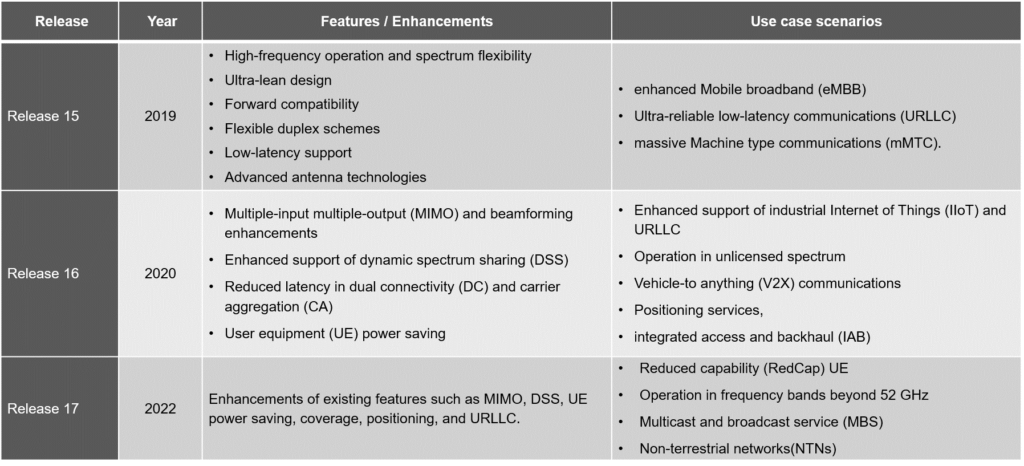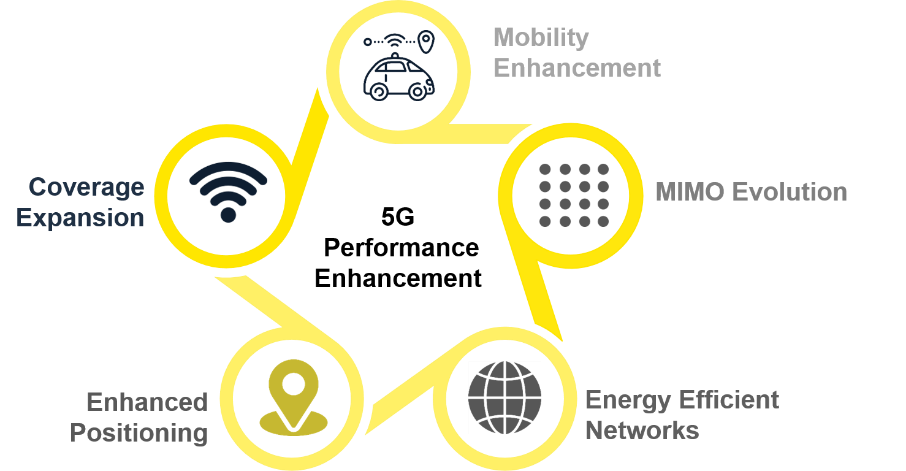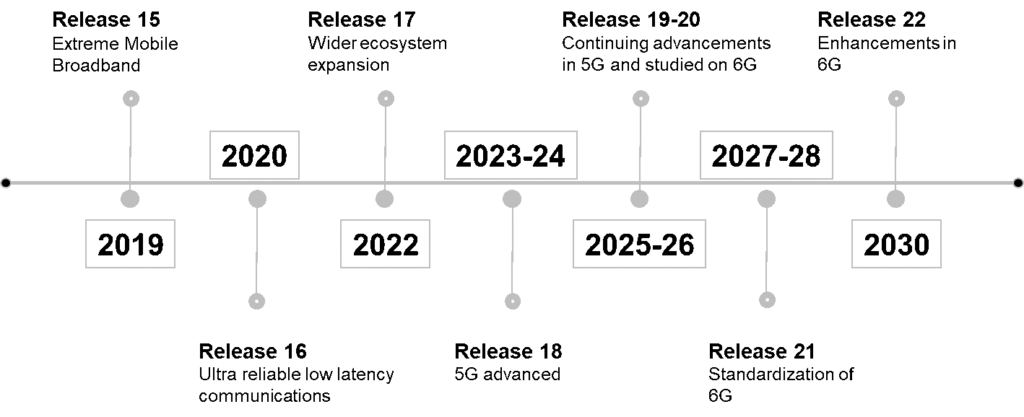5G-Advanced is set to expand 5G to its fullest capabilities. It will comprise a range of innovations offering a plethora of benefits for network and system operators, end-users, and verticals. The 3GPP Release 18 will be the first release of 5G advanced embracing artificial intelligence and machine learning technologies to provide data-driven, intelligent network solutions. Release 18 will further include work items on the enhancement of end-to-end 5G system foundation, efficient utilization of spectrum, network topology, and proliferation of 5G to a variety of devices. It will further pave the way for 6G standardization.
What is 5G Advanced?
To bring a new wave of innovations in wireless technology, the industry is adopting 5G advanced as the next step in 5G technology. The technological advancements will enable improvements in terms of speed, coverage, mobility, and power efficiency. 5G-Advanced will bring out the richest capabilities of 5G over the coming decade, breaking down boundaries and expanding connectivity. 5G-Advanced uses artificial intelligence based on machine learning techniques at different levels of the network for intelligent network management and solving multi-dimensional optimization issues in network operations.
3GPP Release 18 for 5G Advanced
3GPP completed the first release of 5G technology, which laid down the basis for commercial 5G deployments, in Release 15 in June 2018. Since then, 3GPP has been working on evolving 5G technology in its Releases 16 and 17 to improve performance further and address new use cases. Recently, 3GPP has approved the work package for Release 18 which will mark the start of 5G advanced evolution.

The table below indicates the key features and use case scenarios addressed in 3GPP Releases 15, 16, and 17.
The 5G advanced evolution will be set by 3GPP Release 18. The release envisions pushing technology boundaries. The work items in Release 18 will cover the following aspects:
Performance Enhancement of the End-to-End 5G System
3GPP is continuously striving to add functionality in Release 18 in the areas of mobility, MIMO, energy-efficient networks, positioning, and coverage, as illustrated in Figure 2. It will collectively lead to enhancing the overall performance of 5G systems.

Mobility Enhancement
Mobility management is an essential feature of mobile networks that offers service continuity when moving from the coverage area of one cell to another. 3GPP release 18 will introduce mechanisms and procedures for layer 1 (L1)/layer 2 (L2) based inter-cell mobility to reduce the latency, overhead, and interruption time associated with current Layer 3-based mobility management. Further, Release 18 will also support conditional handover.
MIMO Evolution
3GPP release 18 will study improvements in multi-user MIMO (MU-MIMO) by exploring channel state information (CSI) reporting enhancements and a larger number of orthogonal demodulation reference signal (DMRS) ports for MU-MIMO. It will further investigate the support of eight antenna ports in uplink and simultaneous multi-panel uplink transmission to better support advanced UEs such as customer premise equipment (CPE), fixed wireless access (FWA) devices, and vehicular UEs.
Energy-Efficient Networks
3GPP has approved a study on green networks that aims to define a network energy consumption model for a base station (BS), develop an evaluation methodology, and identify key performance indicators (KPIs). The study will further investigate techniques to improve network energy savings in targeted deployment scenarios.
Enhanced Positioning
3GPP Release 18 will investigate solutions to further improve accuracy, integrity, and power efficiency in positioning, study sidelink positioning, and investigate positioning support for RedCap devices.
Coverage Expansion: In Release 18, 3GPP intends to improve the physical random access channel’s coverage and investigate strategies for increasing the UE power limit for CA and DC while lowering the maximum power reduction or peak-average-power ratio. The uplink will also be investigated for dynamic switching between cyclic-prefix orthogonal frequency-division multiplexing (CP-OFDM) and discrete Fourier transform (DFT) spread OFDM (DFT-S-OFDM).
5G Advanced: Advantages and Vital Features
- Consistently providing sub-10cm accuracy for enhanced positioning, both indoors and outdoors, along with time synchronization as a service, it offers significant advantages for various applications, including smart power grid control, industrial automation, and real-time financial transactions.
- The emergence of new device types other than smartphones, which do not require the same level of high performance and flexibility, has considerably reduced device costs
- Transformation of the network to enable high-precision location, presence, and timing technologies, profoundly impacting extended reality experiences and energy efficiency through AI/ML data collection and analytics
- Improved spectral efficiency and energy savings, pushing the limits of spectral efficiency in both sub-7 GHz and mmWave spectrums
5G Advanced: Flexible Spectrum Usage
Maximizing societal benefit requires wise management of the limited resource spectrum. Release 18 of the 3GPP will add new features to allow for more flexible and efficient spectrum use for 5G deployments in a variety of situations with variable spectrum allocations. The following study propositions are made in release 18 for efficient spectrum utilization:
- Necessary changes to support deployments in spectrum allocations less than 5 MHz
- NR physical downlink control channel (PDCCH) can transmit in symbols overlapping with LTE cell-specific reference signal (CRS) to increase the PDCCH capacity for DSS. Also, the feature of configuring UE with multiple LTE CRS) rate matching patterns in multi-TRP will be made available to a single TRP scenario to help mitigate inter-cell interference.
- Introducing a functionality that allows a single downlink control information (DCI) to schedule multiple physical downlink shared channels across carriers and study enhancements for multi-carrier uplink operation.
- Feasibility of allowing the co-existence of downlink and uplink at the same time within a conventional TDD band. In other words, the duplex will become a mix of TDD and FDD.
- Cross-link interference (CLI) handling to better support dynamic TDD in commercial deployments.
5G Devices and Use Case Proliferation
3GPP Release 18 will continue to research and introduce tailored functionalities to enhance and expand 5G capability to serve not only smartphones but also a wide range of 5G devices, including extended reality (XR) and cloud gaming devices, low-complexity UEs, vehicular devices, and unmanned aerial vehicles (UAVs), as illustrated in Figure 2. The following study propositions are part of 3GPP Release 18 for 5G devices:

- Enhancement of the In-device coexistence (IDC) feature by allowing devices to indicate the affected frequencies with finer granularity and preferred TDD pattern
- Enabling multi-SIM devices to indicate preferred capability restriction when switching between networks
- Enhancements to support RedCap devices of low complexity and reduced device bandwidth to 5MHz
- Low-power wakeup receiver architectures, design of a wake-up signal, and procedure and protocol changes to support the wake-up receiver and signal
- Support for mobile terminated small data transmission in RRC inactive mode
- Enhance sidelink communication to support vehicular devices used in V2X services
- Support for devices on-board aerial vehicles (i.e., UAVs) and enhancements for broadcasting UAV identification and signaling to indicate UAV beamforming capabilities
- In the coming years, anticipate a proliferation of Extended Reality (XR) and cloud gaming devices. Therefore, the following study propositions are being considered in 3GPP release 18:
- Investigation of resource allocation and scheduling mechanisms that can improve capacity for XR and cloud gaming devices
- Power-saving techniques to accommodate XR and cloud gaming devices
- Making RAN more XR-aware by identifying the application information beneficial for RAN to be aware of and how to utilize the information in RAN to handle XR and cloud gaming traffic.
AI-Powered 5G and Data-Driven Networks
5G devices generate a huge amount of data, making the networks more complex. To efficiently manage the networks, leveraging AI techniques to enhance existing data collection and improve air interface functions is becoming crucial. The following study propositions are available in 3GPP release 18 pertaining to AI-powered and data-driven networks:
- Data collection enhancements and signaling support for a set of selective AI-based use cases, including network energy saving, load balancing, and mobility optimization.
- Enhancement of NR data collection within the scope of the self-organizing network (SON)/minimization of drive testing (MDT).
- Enhancing the NR QoE framework to support new types of 5G services, such as XR, cloud gaming, and MBS.
- Establish a common AI/ML framework, identify areas where AI/ML can improve air interface functions, investigate how to describe and characterize AI/ML models, evaluate AI/ML techniques to understand their gains and complexity, and assess standardization impact.
Conclusion

Advancements in wireless network technologies are paving the way for 6G, which experts expect to become the next platform of innovations by the end of this decade. As indicated in the 3GPP timeline, the standardization for 6G is expected to start in 3GPP around 2025.
Researchers anticipate that the innovative works conducted in 5G Advanced will trigger a paradigm shift, establish a strong foundation for 6G design, and profoundly impact future wireless networks. Moreover, blockchain is triggering 5G Advanced